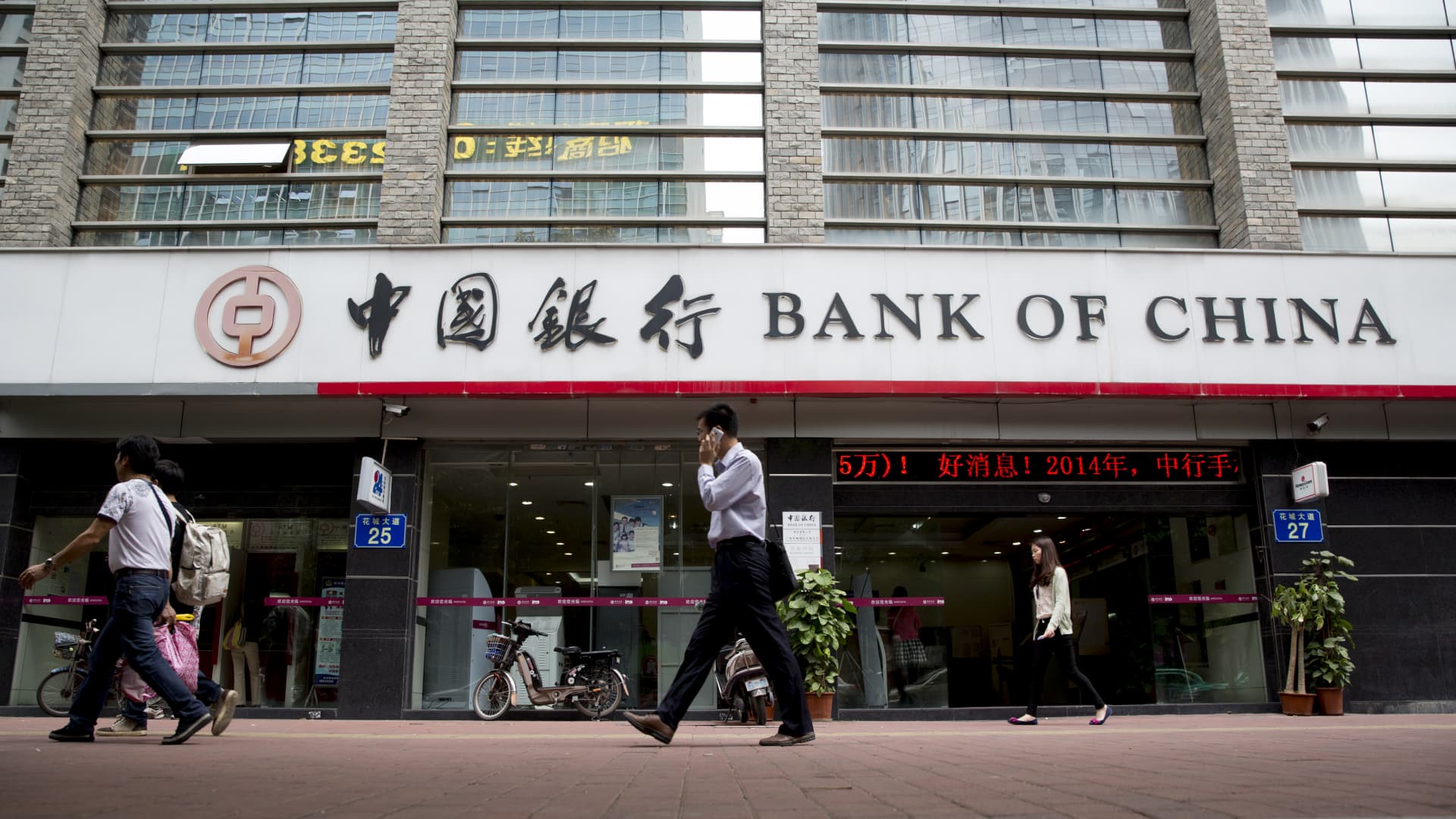A man with a mobile phone walks past a Bank of China Ltd. branch. in Guangzhou, Guangdong Province, China, on Thursday, March 27, 2014.
Brent Lewin | Bloomberg | Getty Images
China’s biggest state-owned banks are likely to see their record low profit margins fall further as Beijing’s broader stimulus package comes into play, analysts say.
Net interest margins (NIM), a key indicator of bank profitability, at China’s “Big 4” lenders – Industrial and Commercial Bank of China (ICBC)China Construction Bank, Bank of China, Agricultural Bank of China – fell by an average of about 20 basis points in the first nine months of 2024 from a year earlier, CreditSights analysts said in a report.
ICBC, the world’s largest lender by assets, was the only major lender among the Big 4 to report flat NIM in the third quarter compared to the previous quarter, at 1.43%. However, this was 18 basis points lower than earlier this year.
Among its smaller rivals, Bank of China and China Construction Bank’s profit margins fell to 1.41% and 1.52% respectively, down from 1.44% and 1.54% in the previous quarter.
In an economic slowdown, China’s $60.6 trillion banking industry has faced weakening profitability under the weight of lower mortgage rates and weak credit demand.
At the end of June, commercial banks’ gross margins fell to 1.54%, a record low, according to official data from the national financial regulatory administration. This is well below the 1.8% threshold that regulators see as necessary to maintain reasonable profitability.
Since late September, Beijing has stepped up monetary stimulus, pressuring the biggest banks to provide cheaper and faster credit to ease a long-running property crisis and huge local government debt.
Major lenders are waiting for a recapitalization package from Beijing to help replenish capital and strengthen their ability to support the recovery in the economy.
“We expect NIM to see a small contraction in the fourth quarter and a larger decline in the first quarter of 2025,” Karen Wu, an analyst at CreditSights, told CNBC.
That forecast matched an annual forecast from analysts at Morningstar. They see NIM for state-owned banks shrinking by 15-25 basis points in 2024 and “mid-to-high single-digit basis points” next year.
Falling rates
In recent months, the People’s Bank of China had issued a series of monetary easing measures, including a 20 basis point cut in the 7-day reverse repo rate and a 25 basis point cut in the key 1-year lending rates and 5 years old. (LPR).
The central bank also cut lending rates on existing mortgages, while reducing the amount of cash banks must hold as reserves.
Those cuts prompted banks to cut deposit rates, hoping to ease their funding costs and cushion the blow to already low margins, said Kenny Lim, China banking analyst at UOB Kay Hian.
However, most banks expect NIM tightening to be “neutral” in the long term, according to their earnings reports last week. This is because “the effect of mortgage rate cuts and LPR cuts on NIM will be mitigated by reductions in [reserve requirement ratio] and deposit rates,” said Vivian Xue, director of APAC Banks at Fitch Rating.
However, it takes less time for banks to cut lending rates compared to deposits, which can be repriced lower after maturity, Lim said, reiterating short-term pressure on banks’ profit margins.
Application for soft loans
Weak credit demand has shown no signs of recovery, analysts said, as households and businesses remain cautious about spending.
China’s aggregate financing, a broad measure of credit, showed a year-on-year decline of 12.6% in the first nine months, with new RMB-denominated loans falling 22.2% in September alone.
“With credit growth still contracting, it remains too early to declare a turnaround,” Lynn Song, chief economist for Greater China at ING Bank, said in a note.
Chinese authorities need to do more to boost “initial credit impulse,” which is still missing, Jason Hsu, founder and chief investment officer of Rayliant Global Advisors, told CNBC’s Pro last month. “There are cheap loans available, but people are not ready to borrow.”
Any recovery in lending could be “very incremental” in the next six months, he added.

Recapitalization in focus
China had planned to inject additional capital into six of its major commercial banks, a senior financial regulator said in September, without elaborating on the size or timing. Bloomberg later reported that the recapitalization could be as much as 1 trillion yuan ($142 billion).
Any major fiscal stimulus is expected to be approved by the authorities at the National People’s Congress standing committee, which is taking place this week. Earlier this week, People’s Bank of China Governor Pan Gongsheng said the central bank planned to maintain accommodative monetary policy.
The recapitalization “must happen for Chinese banks to survive the low net interest margin,” said Alicia Garcia Herrero, chief economist for Asia Pacific at Natixis. Otherwise these banks would not be able to “broker any stimulus that may come.”
The move, if implemented, would be the first time since the global financial crisis in 2008 that Beijing injected capital into its big banks.
An injection of capital is likely to boost investor confidence while providing negative support for credit growth, Iris Tan, senior equity analyst at Morningstar, said in a note.
